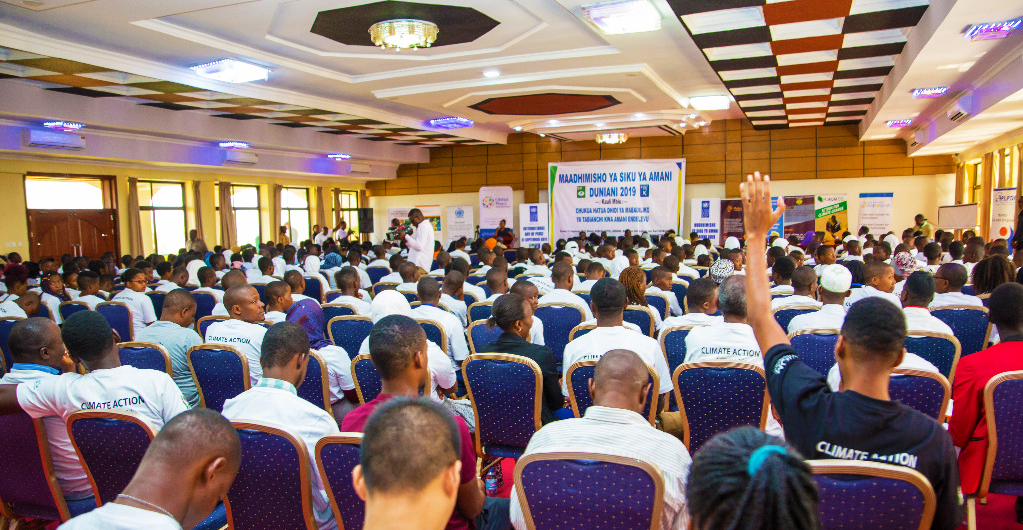
UNIC Dar es Salaam and Partners in partnership with GNRC–Tanzania, Dodoma Youth Development Program (DOYODO), Global Peace Foundation Tanzania, Youth of United Nations Association of Tanzania, Organization for Peace and Consensus, and Interreligious Peace Council of Tanzania (IRPCT) organized a regional meeting to commemorate the International Day of Peace on 21st September 2019. The conference aimed at creating awareness on the climate crisis and enhancing actions towards climate change. The meeting also mobilized ambitions to support the global Climate Action Summit on 23rd September 2019, at the UN Headquarters in New York which aims at developing concrete plans for a cleaner, safer and greener future.
A total of 500 participants including government officials, international and grassroots organizations, faith leaders, parents, youth and children attended the event. Internet Society of Tanzania, Center for foreign Relations, Forum for Climate Change (Forum CC) and International Organization for Migration also supported the event. Representatives from the Tanzania Youth Coalition (TYC), Mulika, Tanzania, PLPDF, PRST AREPEB, Bright Jamii Initiative and the Jane Goodall Institute were also in attendance. The Minister of State in the Vice President’s office Union and Environmental Affairs, Mr. George B. Simbachawena; the Dodoma Regional Commissioner, Dr. Binilith Saton Mahenge; the Director of Public Persecution (DPP) Tanzania, Mr. Biswalo Mganga; and the United Nations Environment Programme (UNEP) Representative Tanzania, Ms. Clara Makenya, graced the event.
During the meeting the need to safeguard the environment against pollution and exploitation was highly emphasized. Participants mentioned that human activities across the world have largely changed the climate from how it was before and the changes are presently affecting the world through global warming. Members warned that the adverse impact of the climate crisis, if not addressed promptly, would affect the world on a larger and much worse scale. Contamination of water sources, increased drought incidents, melting of polar ice sheets, and rising of temperatures were some of the examples cited as glaring indicators of the climate crisis, and participants feared the worst is yet to come.
The meeting recommended the world’s leaders to take drastic action towards addressing climate change and ultimately promote peace and stability. They recommended leaders and professionals to provide guidance and support to communities and to the young generation by developing and sharing knowledge on smart measures towards a green world such as advocating for emission free industries and automobiles, reducing natural resource exploitation among others. They also recommended for the community to be sensitized on waste management.
Annex
Summary of the Peace Day in Tanzania
- Peace is a major catalyst for the development of any nation in the world. It is the duty of each of us to maintain, protect and sustain our peace for sustainable development.
- Climate change is a threat to peace and security of human being as it affects all sectors and systems of human life.
- Over 95% of climate change is influenced by human activities; Survivors of Climate Change are humans themselves; And the solution to the problem of climate change will be solved by humans themselves.
- In order to facilitate measures to withstand and adapt to climate change, it is important that the government to continue taking lead by putting in place an enabling environment through policy frameworks, law enforcement, budgetary enervation and participatory strategies that will guide citizens and various stakeholders in taking joint efforts against climate change for sustainable peace.
- Despite the current and ongoing efforts by the government to control climate change, it is important for everyone, in their place, in their area and in their own means to take action against climate change in order to achieve sustainable peace.
- Education on climate change should be provided to the public in the formal system (through education curricula in schools and colleges) as well as in the informal system (through the media, religious gatherings and various workshops) to create a better understanding of the people on this challenge, including providing guidance on the steps to be taken
- Some of the effects of climate change can be opportunities, and young people are eager to take advantage of them. For example designing renewable energy, waste management, sustainable charcoal, Climate Smart Agriculture etc.
- Taking action against climate change is a way to maintain peace, so we are all at the forefront of taking action now.

